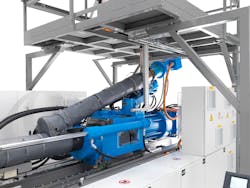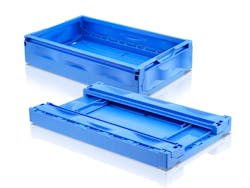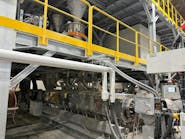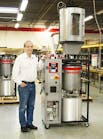By Karen Hanna
A compounding and injection molding machine (IMM) setup from KraussMaffei will save virgin resin and make in-house recycling easier for processors serving the automotive and logistics industries, the company says. The new technology even works with disparate materials.
Available since the summer, KraussMaffei’s new Direct Compounding Injection Molding [DCIM] machine is the arrangement of a single-screw extruder positioned directly over the injection unit of the press.
“Material costs can be reduced by 30-50 percent on the polymer side by self-compounding. Energy can be reduced tremendously,” said Franz-Xaver Keilbach, product manager for DCIM and circular economy.
The arrangement is appropriate in combination with either KraussMaffei’s CX and GX IMMs, with clamping forces ranging from about 180 tons to 1,236 tons.
The extruder and IMM work in turns, so that when the shot has been built up for one cycle, the extruder stops.
The system carries compounded melt into the plasticizing unit, without the need for cooling or storage, reducing potential degradation of the polymer.
According to the company, the DCIM is appropriate for parts weighing about 1.8 ounces to about 4.4 pounds.
At the K show, the arrangement will transform a combination of three materials — PP staple fiber fleece from masks, shredded HDPE from packaging and HDPE blow molding scrap from toys — into 2.2-pound, five-piece polyolefin (PO) collapsible crates. The process also will include three virgin materials used as fillers: masterbatch, stabilizer additives and micaceous iron oxide.
Enabling the recycling of the materials, which have widely varying melt volume rates, is a special, very long screw. While the screws in standard IMMs typically have L:D ratios ranging from 17-to-1 to 23-to-1, the DCIM’s screw has an L:D ratio of 30-to-1, and it’s capable of producing a very homogenous melt.
Working in 35-second cycles, KraussMaffei’s K show work cell will include an LRX 350 linear robot, also from the company, that will remove the five parts ofthe crate from the mold and transfer them to an automation system for clipping and stacking.
The company says the DCIM offers a plethora of benefits to users, who will be better able to recycle materials in their own plants.
“As one step of melting can be saved, and as the machine compounds directly in front of the tool, we are sure that many customers will add a certain amount of recyclates into the recipe. Furthermore, blow molding waste that is not processable with standard machines can be processed and injected,” Keilbach said.
Also, because they can perform compounding on site with it, users will enjoy more control over the characteristics of various polymer blends and PP and polyamide glass-fiber compounds.
KraussMaffei estimates that processors supplying parts for packaging and logistics might save up to 50 percent of material costs using the DCIM.
Asked what materials can be blended, Keilbach indicated that processors will have plenty of flexibility. The system can handle combinations with as many as eight materials.
“Up to now, we do not see many limits,” Keilbach said.
The system can handle compounds that have a total glass-fiber composition of up to 60 percent. However, it cannot handle PVC or powders.
The one-step process conserves energy and reduces users’ carbon dioxide footprint, the company says.
DCIM users aren’t restricted to processes involving both compounding and injection molding, either. According to the company, the DCIM can be used as a standard IMM, if no compounding is required.
Karen Hanna, senior staff reporter
Contact:
Krauss-Maffei Corp., Florence, Ky., 859-283-0200, www.kraussmaffei.com
Karen Hanna | Senior Staff Reporter
Senior Staff Reporter Karen Hanna covers injection molding, molds and tooling, processors, workforce and other topics, and writes features including In Other Words and Problem Solved for Plastics Machinery & Manufacturing, Plastics Recycling and The Journal of Blow Molding. She has more than 15 years of experience in daily and magazine journalism.

![KraussMaffei’s new Direct Compounding Injection Molding [DCIM] machine is the arrangement of a single-screw extruder positioned directly over the injection unit of the press. KraussMaffei’s new Direct Compounding Injection Molding [DCIM] machine is the arrangement of a single-screw extruder positioned directly over the injection unit of the press.](https://img.plasticsmachinerymanufacturing.com/files/base/ebm/pmm/image/2022/09/DCIM__1_.6310b297b6512.png?auto=format,compress&fit=max&q=45&w=250&width=250)






